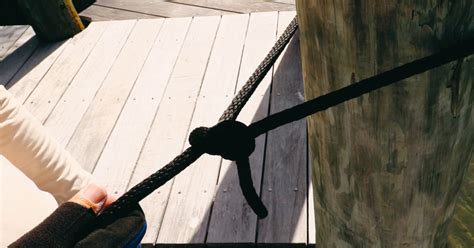How To Tie A Boat To A Piling
Ronan Farrow
Mar 26, 2025 · 3 min read

Table of Contents
How to Tie a Boat to a Piling: A Comprehensive Guide
Tying your boat securely to a piling is a crucial skill for any boater. Whether you're docking for the night, taking a break, or waiting out rough weather, a proper knot can prevent damage and ensure the safety of your vessel and others. This guide will walk you through the process, covering different knot types and best practices.
Choosing the Right Knot
The key to a secure tie is selecting the appropriate knot for the situation. Different knots offer varying degrees of holding power and ease of release. Here are a few popular choices:
1. Cleat Hitch:
- Best for: Securing your boat to a cleat on a piling or dock. Cleats are specifically designed for this purpose.
- How to: Form a loop around the cleat's horns, then pass the line around the opposite horn, creating a figure-eight pattern. Take the end of the line and tuck it under the last wrap, securing the knot tightly. This knot is easily undone.
- Advantages: Simple, secure, and easy to untie.
- Disadvantages: Not suitable for tying directly to a piling without a cleat.
2. Bowline:
- Best for: Creating a secure loop at the end of your rope, which can then be wrapped around a piling.
- How to: Form a loop, pass the working end through the loop, around the standing part, and back through the loop.
- Advantages: Extremely strong, reliable, and easy to untie even under load.
- Disadvantages: Can be more challenging to tie quickly than other knots.
3. Round Turn and Two Half Hitches:
- Best for: Securing a line to a piling or post. This is a versatile knot for various applications.
- How to: Make a round turn around the piling, then two half hitches around the standing part of the rope.
- Advantages: Strong and reliable, easy to tie.
- Disadvantages: Can be difficult to untie under significant load, so careful attention should be paid to how tightly it is secured.
Best Practices for Tying Your Boat
Regardless of the knot you choose, follow these best practices for a secure and safe tie-up:
- Use Enough Rope: Leave enough slack in the line to allow for tidal changes and boat movement. A too-tight tie can damage your boat or the piling.
- Inspect Your Lines: Regularly check your ropes for wear and tear. Replace any damaged or weakened lines promptly.
- Consider the Weather: Strong winds or currents may require additional lines or more robust knots.
- Use Fenders: Always use fenders to protect your boat from contact with the piling.
- Double Up: In challenging conditions, consider using two separate lines tied to different points on your boat for added security.
- Know Your Knots: Practice tying these knots before you need them in an emergency situation.
Troubleshooting Common Issues
- Knot Slipping: Ensure the knot is tied correctly and tightly. Consider using a locking mechanism or a stronger knot type if slipping is persistent.
- Rope Breaking: Regularly inspect your ropes for wear and tear, and replace damaged lines. Use appropriately sized and rated rope for the task.
By following these guidelines and selecting the appropriate knot, you can confidently tie your boat to a piling, ensuring a safe and secure experience on the water. Remember, practice makes perfect; take the time to learn and refine your knot-tying skills. Safe boating!
Featured Posts
Also read the following articles
| Article Title | Date |
|---|---|
| How Annandale Went Out Poem Analysis | Mar 26, 2025 |
| How To Restain Fiberglass Door | Mar 26, 2025 |
| Ed Sheeran Concert How Long | Mar 26, 2025 |
| How Well Do You Know Mommy To Be Questions | Mar 26, 2025 |
| How To Tell If Wasp Nest Is Empty | Mar 26, 2025 |
Latest Posts
Thank you for visiting our website which covers about How To Tie A Boat To A Piling . We hope the information provided has been useful to you. Feel free to contact us if you have any questions or need further assistance. See you next time and don't miss to bookmark.
